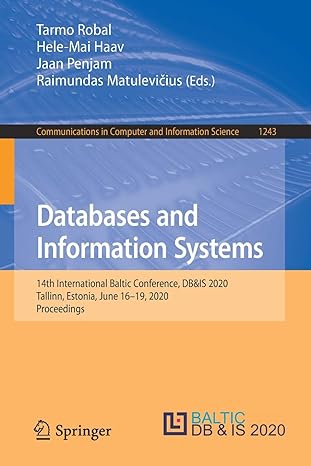Question
What i have for the following has a different outcome. I am on the right track but how can I finish this? i need help!
What i have for the following has a different outcome. I am on the right track but how can I finish this? i need help! Also have screenshots of some of my errors if neded.
Activity 1: The Monty Hall Problem
1. The following is the MatLab code for generating a scatter plot showing the results of running the Monty Hall simulation 100000. Run the code and save the output.
% Code to simulate the Monty hall problem
% The array 'doors' represent the 3 doors
% Door States:
% 0 - uninitialized
% 1 - car
% 2 - goat
% 3 - revealed
% clear everything.
clc
clear all
close all
% Initialize
numOfSimulatedGames = 100000;
numGamesPlayed = 0; successfulSwitch = 0;
probabilityOfSuccess=zeros(1,numOfSimulatedGames);
for numGamesPlayed = 1:numOfSimulatedGames
doors = zeros(1,3);
% Stick a car behind a random door
rNum = 3*rand();
if( (rNum>0) && (rNum<1))
doors(1) = 1;
elseif( (rNum>1) && (rNum<2))
doors(2) = 1;
else
doors(3) = 1;
end
% Fill in the other 2 spots with goats.
for i = 1:3
if(doors(i)==0)
doors(i) = 2;
end
end
% Have contestant randomly pick a door.
rNum = 3*rand();
if( (rNum>0) && (rNum<1))
chosenDoor = 1;
elseif( (rNum>1) && (rNum<2))
chosenDoor = 2;
else
chosenDoor = 3;
end
% Reveal the first goat door that isnt a chosen door.
picked = 0;
for i = 1:3
if(i~=chosenDoor)
if(doors(i)~=1)
if(picked==0)
% door isn't a car, isn't the one the contestant picked
% and we havent revealed yet.
doors(i)=3;
picked =1;
end
end
end
end
% At this point the theory says it's beneficial to switch your choice.
% so, if the door that (hasn't been picked or revealed) is the car, increment
% a variable and calculate the probabiltiy.
for i = 1:3
if(i~=chosenDoor)
if(doors(i)~=3)
% Not chosen or revealed, must be the door we'd switch too.
if(doors(i)==1)
% If we would have switched and won the car
successfulSwitch = successfulSwitch+1;
end
end
end
end
probabilityOfSuccess(numGamesPlayed) = successfulSwitch / numGamesPlayed;
end
xaxis = 1:numGamesPlayed;
figure
plot(xaxis,probabilityOfSuccess);
xlabel('Number of games played')
ylabel('Probability of a succesful switch')
2. Using the code above as a template or start from scratch, generate a version of the Monty Hall problem that would consist of 100 doors rather than only 3 doors. The program should still simulate the same concept. The player chooses one door from the one hundred doors. After the selection is made, 98 doors are opened leaving the player with only two doors again. The player must then switch doors.
Provide a scatter plot and a histogram of the results. Submit the code you have written to generate the graphs.
Does it matter if there are 3 doors or 100 doors? Explain your reasoning and use your outputs as evidence to support your claim(s).
Activity 2: The Birthday Problem
The birthday problem is stated as follows: if there is a group of n people in a room, what is the probability that two or more of them have the same birthday? It is possible to determine the answer to this question by simulation. Write a function that calculates the probability that two or more of n people will have the same birthday, where n is the calling argument.
Hint: to do this the function should create an array of size n and generate n birthdays in the range 1 to 365 randomly. It should then check to see if any of the n birthdays are identical. The function should perform this experiment at least 5000 times and calculate the fraction of those times in which two or more people had the same birthday.
MatLab Portion
Use the function you created above and check to see if it works. Let n = 30 and run the program.
Generate a scatter plot to show what the probability value is being approached.
Provide the code you wrote to support the graph.
*******The following code or any variation of the code that uses the mathamatical function is not allowed. *******
P = 1-365!/(365-n)!/365^n
****************************
Step by Step Solution
There are 3 Steps involved in it
Step: 1

Get Instant Access to Expert-Tailored Solutions
See step-by-step solutions with expert insights and AI powered tools for academic success
Step: 2

Step: 3

Ace Your Homework with AI
Get the answers you need in no time with our AI-driven, step-by-step assistance
Get Started


